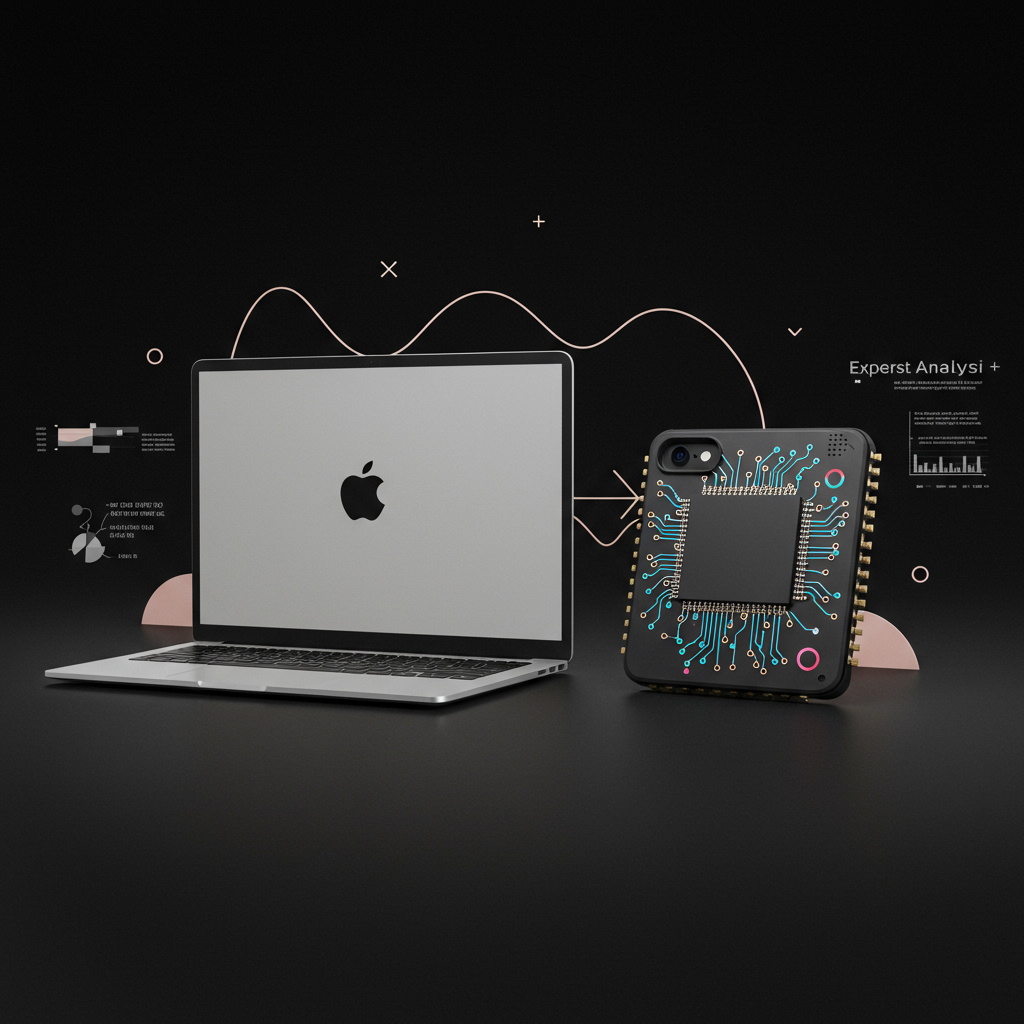Could apple be preparing to launch its most affordable laptop ever? Rumors circulating from reliable sources suggest a groundbreaking shift in Apple’s strategy: a new, low-cost macbook powered not by the familiar M-series chips, but by a chip designed for iPhones. This potential move aims to make the Mac platform more accessible, potentially opening doors for new users and markets. Experts are weighing in on what this budget-friendly machine could offer and what compromises might be necessary to hit a lower price point.
The Whispers Begin: Reports of an ‘Affordable’ Mac
The notion of a significantly cheaper MacBook gained traction thanks to a report from well-known Apple analyst Ming-Chi Kuo. Kuo detailed Apple’s apparent plan to introduce an all-new “affordable” MacBook model. His report indicated this machine would feature an iPhone chip at its core. This prediction alone marked a significant departure from Apple’s recent silicon strategy for the Mac lineup.
Adding fuel to the fire, MacRumors later reported independent evidence supporting Kuo’s claims. They discovered hints of such a device buried within Apple’s backend code. Specifically, code related to Apple Intelligence software spotted last summer provided the initial clue. Subsequent investigation by MacRumors confirmed the device’s expected use of the A18 Pro chip. This internal finding assigned the machine the identifier “Mac17,1.” The convergence of analyst reports and code discoveries paints a compelling picture of a real product in development.
A Fundamental Shift: Mac Meets A-Series Silicon
Integrating an iPhone chip into a MacBook would represent a fundamental change for the Mac platform. To date, every Mac powered by Apple silicon has utilized the M-series family of chips. Chips like the M1, M2, M3, and their Pro, Max, and Ultra variants were designed specifically for the Mac’s performance and power requirements. These M-series chips generally offer higher core counts and support for larger amounts of unified memory (RAM). They also typically provide better external display support compared to their A-series counterparts.
The rumored affordable MacBook, however, is expected to break this mold by incorporating the A18 Pro chip. This powerful mobile processor first debuted in the iPhone 16 Pro model. While highly capable for smartphones, using an A-series chip raises questions about performance characteristics in a traditional desktop/laptop environment.
Expected Capabilities and Limitations
The choice of the A18 Pro chip, while potentially enabling a lower price, comes with anticipated limitations. Experts suggest this chip would likely constrain the new MacBook’s capabilities compared to M-series Macs. Based on the A-series architecture and its typical implementations, several features are considered highly unlikely for this budget model:
Thunderbolt Ports: The high-bandwidth, versatile Thunderbolt connectivity seen on M-series Macs is improbable with an A-series chip.
Unified Memory (RAM) Capacity: Support for more than 8GB of unified memory is not expected. Current M-series Macs often start at 8GB but offer configurations up to 24GB or more.
External Display Support: The device is unlikely to support more than one external display. M-series Macs typically support at least one high-resolution external display, with Pro/Max variants supporting two or more.
These technical constraints underscore the target positioning for this machine. It wouldn’t replace the need for a MacBook Air or Pro for users requiring more demanding tasks or extensive peripheral support. Instead, it would serve as an entry point, similar to how the base iPad differs from the iPad Air or Pro.
Strategic Design Choices to Lower Costs
To achieve the “affordable” price point, Apple is expected to employ cost-saving measures beyond just the chip. One key strategy could involve reusing the design and physical chassis of an older, proven machine. The M1 MacBook Air design is often cited as a potential candidate for this recycling effort.
Utilizing an existing design allows Apple to reduce significant research, development, and manufacturing tooling costs associated with creating a completely new form factor. Reusing a familiar chassis also helps differentiate this new low-cost model. It would visually stand apart from the current, more modern designs of the M2/M3/M4 MacBook Air and MacBook Pro lineups. This mirrors Apple’s approach with some lower-cost iPhone or iPad models that retain older aesthetics.
What’s in a Name? Speculation on Branding
Keeping with the theme of differentiation and potential cost savings, Apple might also opt for simpler branding. The company could choose to revive the straightforward “MacBook” moniker for this entry-level laptop. This would separate it clearly from the “MacBook Air” and “MacBook Pro” segments.
Such a naming convention would also align the Mac lineup more closely with the current iPad family structure. The base model tablet is simply called “iPad,” serving as the most accessible entry point. Similarly, this new laptop could simply be called “MacBook,” positioning it as the foundational option in the Mac portfolio before users step up to the Air or Pro models.
Production Timeline and Market Ambitions
According to Ming-Chi Kuo’s reporting, the timeline for this new affordable MacBook is becoming clearer. The machine is anticipated to enter mass production relatively soon. Kuo predicts mass production will commence either late in the fourth quarter of 2025 or early in the first quarter of 2026.
This production schedule suggests an expected launch window in the first half of 2026. Apple reportedly has significant hopes for this budget offering. Kuo’s analysis indicates Apple believes this model could substantially boost MacBook sales. Sales projections suggest it could account for between 20% and 28% of total MacBook sales in the year following its release. This highlights Apple’s confidence in the potential market demand for a more accessible Mac. Chinese supplier Everwin Precision is expected to be a key beneficiary, potentially providing casings for the new device.
Fitting into Apple’s Broader Strategy
The introduction of a low-cost MacBook with an iPhone chip isn’t happening in isolation. It appears to be part of Apple’s broader strategic adjustments to its device lineups. The external summaries regarding upcoming Apple products offer context. For example, the anticipated iPhone 17 lineup in 2025 is rumored to feature a new, thinner “iPhone 17 Air” model, potentially replacing the ‘Plus’ and slotting into a new mid-tier price point. This suggests a pattern of refining the portfolio to offer tiered options at different price points.
Similarly, the M5 chip is expected to debut in MacBook Pro and iPad Pro models in 2025. The M5-powered MacBook Air is rumored for 2026. This new low-cost MacBook with an A-series chip could effectively create a new, even lower tier below* the traditional MacBook Air. Apple seems to be segmenting its product families more distinctly to capture a wider range of customers, from budget-conscious buyers to professional users requiring maximum performance. Future products like refreshed HomePods, Apple TV, AirTag, and new displays also point to a major refresh cycle ahead, further demonstrating Apple’s focus on evolving its ecosystem.
Potential Implications for the Mac Ecosystem
Introducing an A-series chip into the Mac family carries significant implications. While performance metrics of an A18 Pro in a laptop form factor remain to be seen, it’s likely optimized more for efficiency and basic tasks than sustained professional workloads. This means the low-cost MacBook would appeal primarily to users with less demanding needs.
Target users could include students, individuals needing a basic laptop for web browsing, email, document creation, and light media consumption, or those in emerging markets where current MacBook pricing is prohibitive. This move could significantly grow the Mac user base. However, it also risks fragmenting the platform slightly, requiring developers to potentially optimize more carefully across A-series and M-series Macs. The core value proposition will hinge on delivering sufficient performance for everyday tasks at a compelling price point, combined with the user-friendly macOS experience.
Frequently Asked Questions
What are the key rumored specifications of the potential low-cost MacBook?
Reports suggest the upcoming affordable MacBook is expected to feature a 13-inch display. It is powered by the A18 Pro chip, which first appeared in the iPhone 16 Pro. Rumored color options include silver, blue, pink, and yellow, potentially mirroring iPhone finishes. Internally, the device has been identified as “Mac17,1” in backend code.
What are the expected limitations of a MacBook powered by an iPhone chip compared to current Macs?
Using the A18 Pro chip from an iPhone is anticipated to impose several limitations compared to M-series Macs. The device is considered highly unlikely to include Thunderbolt ports. It is also expected to be limited to a maximum of 8GB of unified memory (RAM) and support only a single external display, constraints typically associated with A-series chip implementations versus the more robust M-series.
When is this new affordable MacBook expected to be released?
According to analyst reports, mass production for the low-cost MacBook with the A18 Pro chip is projected to begin late in the fourth quarter of 2025 or early in the first quarter of 2026. This production timeline suggests that the device is expected to launch sometime in the first half of 2026.
Conclusion
The prospect of a low-cost MacBook powered by an iPhone chip is one of the most intriguing rumors circulating about Apple’s future lineup. By potentially adopting the A18 Pro and reusing an existing design, Apple could finally deliver a Mac at a price point accessible to a much wider audience. While anticipated limitations like restricted ports, RAM, and external display support mean this won’t be a machine for power users, it could be a game-changer for basic computing needs and entry into the macOS ecosystem. With mass production potentially starting by late 2025, a launch in the first half of 2026 seems plausible. This rumored device underscores Apple’s evolving strategy to segment its products more aggressively, aiming to capture different market tiers and significantly boost its overall device sales. The coming months will be crucial for confirming whether this affordable Mac becomes a reality.



